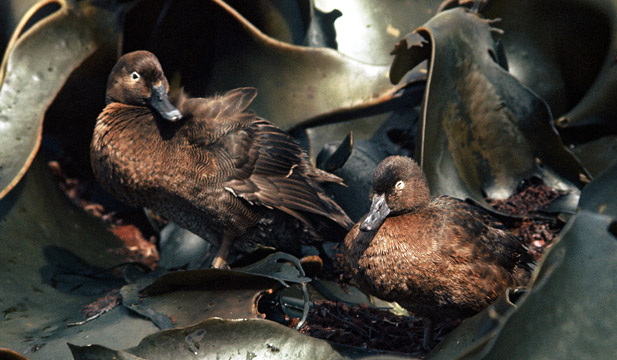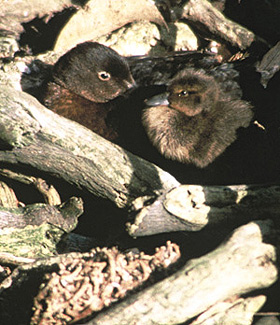|
|
| |
 |
| |
Home > New Zealand ecology > Teal > Auckland Island teal |
| |
| |
| |
The Auckland Island teal Anas aucklandica is a flightless dabbling duck belonging to the Anatidae family of waterfowl (ducks, geese and swans), of the Anseriformes order.
It is endemic to the subantarctic Auckland Islands, with small populations on all substantial islands in the group except the main island.
The islands occupied by teal include Enderby, Ewing, Rose, Ocean and Dundas Islands at the east end of Port Ross off the northeast coast, Adams Island in Carnley Harbour in the south, and Disappointment Island to the west. |
| |
 |
| |
Above: An Auckland Island teal Anas aucklandica mother with her duckling nestled amongst driftwood.
Photo Crown Copyright © Department of Conservation.
 View slideshow of larger images View slideshow of larger images |
| |
 |
| |
Records from the 1940s show teal once bred on the main Auckland Island, but became locally extinct following the introduction of domestic animals. Cattle, goats and rabbits introduced as food for shipwrecked sailors have been removed.
Teal are expected to return to the main island when pigs and cats are eventually removed, however, this remains a massive eradication that is not yet proposed.
Cattle, rabbits and mice have been eradicated from Enderby Island, and rabbits from Rose Island, leaving all teal-inhabited islands free from introduced mammals.
The Auckland Island teal has had an easier survival than its close relative, the Campbell Island teal Anas nesiotis. Unlike Campbell Island where rats nearly caused the extinction of teal, and despite many shipwrecks, rats have never got ashore on any islands in the Auckland Islands group.
The threatened status of Auckland Island teal has worsened. The 2005 New Zealand Threat Classification System listed it as 'range restricted', but in 2009 the listing was upgraded to 'nationally vulnerable'. The qualifiers are 'island endemic', 'stable' and 'range restricted' for 1,000 to 5,000 mature birds.
The IUCN Red List of Threatened Species listing has remained 'vulnerable'. According to Birdlife International, various total population estimates range from 600 to 2000 birds.
Rat infestation from vessels is always a major concern, however, teal occupation of seven islands is good security. |
| |
 |
| |
|
|
| |
 |
| |
Above: A pair of Auckland Island teal Anas aucklandica roosting amongst bull kelp Durvillea antarctica on Rose Island.
Photo Rod Morris, 1973 Crown Copyright © Department of Conservation.
 View slideshow of larger images View slideshow of larger images |
| |
 |
| |
Four of the world's flightless ducks and the most southerly duck locations
New Zealand's two subantarctic teals are the smallest of the Australasian teals, with shorter pointed wings. They are semi-nocturnal and a mix of sea duck and terrestrial duck, feeding and roosting in kelp beds on the shoreline, as well as on land.
There were previously three Anas aucklandica [Grey, 1844] subspecies, but the species was split in 1999 [Daugherty et.al] into the two subantarctic birds A. aucklandica and Campbell Island teal A. nesiotis, and the mainland brown teal A. chlorotis.
Both subantarctic species have been isolated in New Zealand for a long time, and subsequently became flightless and nocturnal. Brown teal Anas chlorotis is a more recent natural immigrant from Australia. |
| |
 |
| |
Habitat destruction, introduced predators and over-harvesting have caused koura populations to decline (Department of Conservation) |
| |
 |
| |
The subantarctic teals are two of the world's few remaining flightless ducks. Others include two species of flightless steamer duck, Tachyeres pteneres from Tierra del Fuego, Chile at the bottom of South America, and Tachyeres brachypterus which is endemic to the Falkland Islands.
At latitude 50.5° South, the Auckland Islands are the world's third most southern duck location, behind the Campbell Islands at latitude 52.5° South, and Tierra del Fuego at latitude 54.9° South.
Teal in the Auckland Islands use dense vegetation along sheltered coastlines as nesting cover. There is consistent occupation along the north shoreline of Adams Island in Carnley Harbour.
They occupy tidal zones, kelp beds, coastal pools, freshwater streams and pools up to 200 metres inland, and tussock grassland - nesting around sedges, amongst fern or beneath logs.
Subantarctic teal are mainly crepuscular (active at dawn and dusk) to nocturnal, so most foraging on the shorelines is done during the evening. They feed on marine invertebrates, terrestrial amphipods, insect larvae and small molluscs in coastal pools, seaweed, and algae.
Pairs are primarilly solitary, maintain a territory, and roost, move about and feed together, but may at times flock at roosting sites. In the breeding season juveniles and single adults make up most of the flock.
The breeding rate is low, with clutches of three to four eggs laid after late October, and broods appearing in December after a 30-day gestation. It has been found that captive one-year olds breed, and translocated birds on Campbell Island bred at the first opportunity after landing in their new home.
The female sits on the nest, and the male guards the female when she is feeding. As typical of ducks, both parents take care of their young throughout 60 to 70 days of fledging.
Their dark chestnut brown cryptic colour is good camouflage amongst the kelp fronds. A fine white ring surrounding the eye is a prominent identifying feature.
Breeding males have an iridescent green sheen on the nape of their necks, while females remain dark brown with a paler abdomen. The male is larger, weighing 500 to 620 grammes, with the female 420 to 560 grammes. |
| |
 |
| |
|
|
Tough little survivors in a tough environment
In 1849, three ships brought settlers to Port Ross on the northern tip of Auckland Island at latitude 50.5° south longitude 166.2° east.
The settlers very quickly became disillusioned with the consistent westerly gales and rain, long winter, and impossible farming conditions, and abandoned the island after two years. The cobblestone street, church and houses of the Hardwicke settlement have completely vanished.
Domestic livestock struggled and humans could not live in the extreme subantarctic conditions, but Auckland Island teal have survived for thousands of years.
| |
 |
| |
Livestock struggled, and humans could not live in the extreme subantarctic conditions, but Auckland Island teal have survived for thousands of years. |
| |
 |
| |
The main Auckland Island is not yet pest free. The removal of pigs and cats will be difficult because of the large area of 51,000 hectares, difficult terrain, and severe climate. It will be a greater challenge than any pest eradication carried out so far in New Zealand.
The Auckland Islands group has 200 native taxa, more than any of the other subantarctic islands. While the taxa is limited in diversity compared to mainland New Zealand, the lack is made up in abundance, such as the massive bull kelp Durvillaea antarctica.
Its' forests are some of the most southern in the world. The montane dwarf forest is limited to 5 metre high Dracophylum and Coprosma species.
Forest in coastal areas and sheltered gullies contain a small version of southern rata Metrosideros umbellata with an entangled profusion of twisted, knarled trunks, and a tight, flattened canopy resulting from the constant wind. The forest floor is mainly free of shrubs because of the acidic peat soils.
The Auckland Islands group has the most diverse avifauna of the five subantarctic islands. The most outstanding group are the 17 breeding species of albatross and petrel.
There are four endemic land birds, the Auckland Island snipe Coenocorypha aucklandica aucklandica, Auckland Island rail Lewinia muelleri, and Auckland Island tomtit Petroica macrocephala marrineri.
The Auckland Islands have the largest population of endemic, endangered yellow-eyed penguin Megadyptes antipodes.
Ewing Island is the most southerly location of New Zealand red-crowned parakeet Cyanoramphus novaezelandiae novaezelandiae, and yellow-crowned parakeet Cyanoramphus auriceps.
The Auckland Islands have the largest population and are the primary breeding location of New Zealand sea lion Phocarctos hookeri, the most critically endangered of the world's sea lions. The New Zealand fur seal Arctocephalus forsteri is also present.
The native freshwater fish koaro Galaxias brevipinnis, is found on Auckland and Campbell Islands.
|
| |
 |
| |
|

